APOGS #16: To live is a crime
Part Five, Chapter VII. Carnivores & Chapter VIII. Imperfect Contrition
'There are periods in revolution when to live is a crime, and people must know how to yield their heads if they are demanded. Perhaps mine will be. If that time comes, I won't dispute it.'
last week | main page | reading schedule | cast of characters | further resources
Hello and welcome to this slow read of A Place of Greater Safety by Hilary Mantel. To get these posts in your inbox, turn on notifications for ‘2025 A Place of Greater Safety’ in your subscription settings.
This week, we are reading Part Five, Chapter VII. Carnivores & Chapter VIII. Imperfect Contrition.
Once you have read this week’s reading, you can explore this post and discuss in the comments. The reading schedule, cast of characters and further resources can be found here.
I start each post with a summary of the week’s story, followed by some background, footnotes and tangents.
And then it is over to you. In the comments, let us know what caught your eye and ask the group any questions you may have. And if you’ve tumbled down a rabbit hole or taken your reading off on a tangent, please share where you have been and what you have found.
This week’s story
It is April 1793, and Danton sits on the Committee of Public Safety, with views of the Place de la Révolution, where the guillotine and M. Sanson do their work. The Tribunal is busy, with Camille’s cousin Fouquier in charge. In these early days, it “often acquits… Take Marat, for instance.” The People’s Friend dodges the guillotine and is carried shoulder-high through the streets.
Camille goes to see an ailing Robespierre, the day he is to denounce the Gironde at the Jacobin Club. Max alarms his school-friend by voicing his doubts about these men’s guilt. Camille tells him of Marat’s rescue of Anne Théroigne, now a Girondist. He remembers the day he defended Marat in the Convention, and the soldiers who offered to take him to “a place of greater safety.”
‘The grave.’ Camille said. ‘The grave.’
Danton negotiates with the Gélys for their daughter’s hand. Louise makes the condition of a good Catholic marriage. Danton must make his confession.
At the end of May, the Paris Sections and National Guard arranges an armed demonstration to throw the Girondists out of the National Convention. The deputies flee, and Manon Roland is captured. Danton makes his confession with imperfect contrition. Robespierre and Camille have a chat that leads to Max opening a file on Danton.
June, 1793. Arthur Dillon is arrested, and Camille rushes to his defence. He visits Marat in his bath, who warns him not to make the welfare of aristocrats his concern. Camille defends Dillon at the Convention and fantasises about killing Saint-Just.
On 13 July, Marat is assassinated in his bathtub. Danton says it is a Girondist conspiracy. Camille visits Marat’s apartment and is insulted by a sans-culotte. He insults Legendre in turn. Marat is given a state funeral, his sacred heart conveyed to the Cordeliers Club. Robespierre looks like he’s throwing out the rubbish.
One day she stirs from her reverie and says, do you know, Georges-Jacques, I sometimes think I may have fantasized the Revolution completely – it seems too unlikely to be true. And Camille – what if he is something I have simply fabricated, just a phantom I have called up out of the depth of my nature, a ghostly second self who works out my discontents?
Background
If you are listening to Mike Duncan’s Revolutions podcast, then I recommend listening to:
With France now at war with most of Europe and its provinces in open revolt against Paris, inflation and food shortages are fueling serious unrest in the capital. The Enragés and sans-coulotte are on the march, demanding more radical reforms such as price controls to ensure everyone can afford to eat.
Their main targets are the Girondist deputies of the National Convention. On 10 March, they failed to get Brissot et al. thrown out, because although the Mountain hates the Gironde, they also fear mob rule and oppose price controls.
The Gironde goes on the offensive against Robespierre, Danton and then Marat – the last of whom is successfully impeached and hauled in front of the Revolutionary Tribunal. On 24 April, he is acquitted, emboldening the sans-coulotte further.
By the end of May, the situation had swung against the Gironde. Robespierre now backs a new Insurrectionary Commune that has the support of the National Guard and calls for the expulsion of the Girondist deputies. The National Convention is besieged, and the chief Girondists are put under house arrest or flee.
With the Gironde out of the Convention, the Mountain makes haste at drawing up a new constitution full of red meat for the Enragés and sans-coulotte. Saint-Just plays a central role in this process. Marat’s illness keeps him away from the Convention, and he is at home in his bathtub on 13 July when Charlotte Corday enters, wielding a knife.

Footnotes
1. The architecture of terror
… no wonder this business is such a bloody mess, no one ever knows what anyone is saying. No one knew at Versailles; no one knows now; when we are dead and a few years have passed they will grow tired of trying to hear us, they will say, what does it matter? We have elected our own place in the silences of history, with our weak lungs and our speech impediments and our rooms that were designed for something else.
“Carnivores” begins with a sweeping shot of the architecture of the Terror. We see Danton sitting in the former private office of Louis the Last, now the office of the Committee of Public Safety. He finds all the green cloth “negative, disturbing.”
From his desk, he imagines “he can hear Sanson making a living”, making a killing with the guillotine in the Place de la Révolution. The traitors of the revolution are sent there directly and swiftly from the Revolutionary Tribunal, where Camille’s cousin, the accusateur public Antoine Fouquier-Tinville, earns his posthumous title of Provider of the Guillotine.
This apparatus is all sanctioned by the National Convention, which has moved from the former equestrian training ground to the theatre within the Tuileries. Rather ominously, it was also known as the Room of Machines due to its elaborate stage machinery. It is an enormous space, in which no one can be heard or seen:
When the lamps are lit, the effect is ghastly; they deliverate in catacombs, and accusation drips from unseen mouths. In a greater dimness, the public galleries barrack and bay.
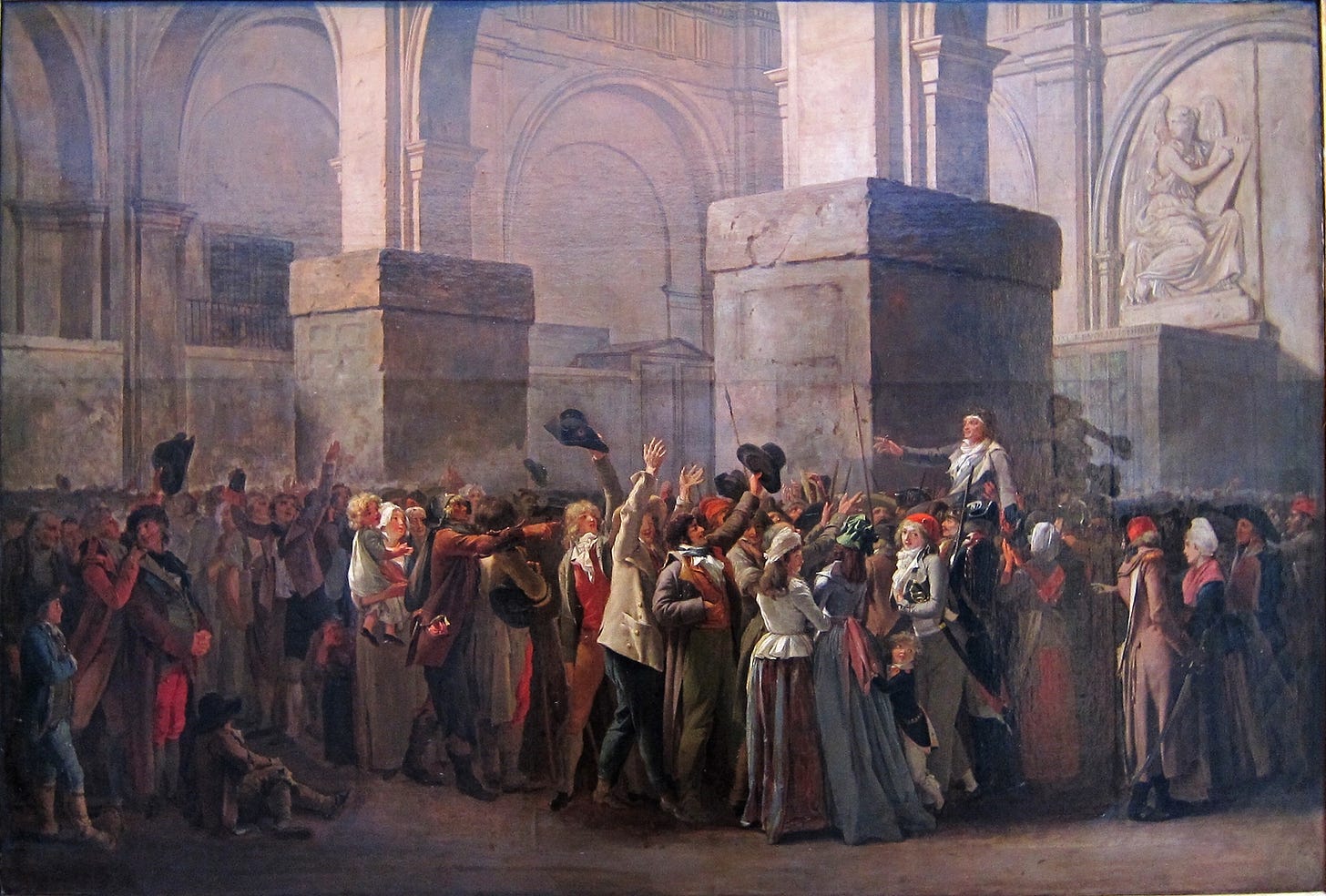
2. Triumph of Marat
Odd really, I never thought of Marat having a beginning, I thought he was thousands and thousands of years old, like Cagliostro.
Alessandro Cagliostro, or Giuseppe Balsamo, was an Italian adventurer, occultist and self-styled magician who was imprisoned and banished for his presumed role in the diamond necklace affair surrounding Marie Antoinette.
As Mantel admits in the Author’s Note, this novel purposefully sidelines Marat’s story so as not to unbalance the narrative of frenemies Robespierre, Danton and Camille. But these two chapters see the climactic triumph of the doctor – acquitted by the Tribunal, purging the Gironde from the Convention – followed by his appropriate death at the hands of an anti-Jacobin assassin.
His words to Camille back in 1789 are coming true:
Thoughtfully the doctor rubbed the bridge of his flat nose: so prosaic, the gesture, the tone. ‘You see what we must do, Camille, is to cut off heads. The longer we delay, the more we will have to decapitate. Write that. The necessity is to kill people, and to cut off their heads.
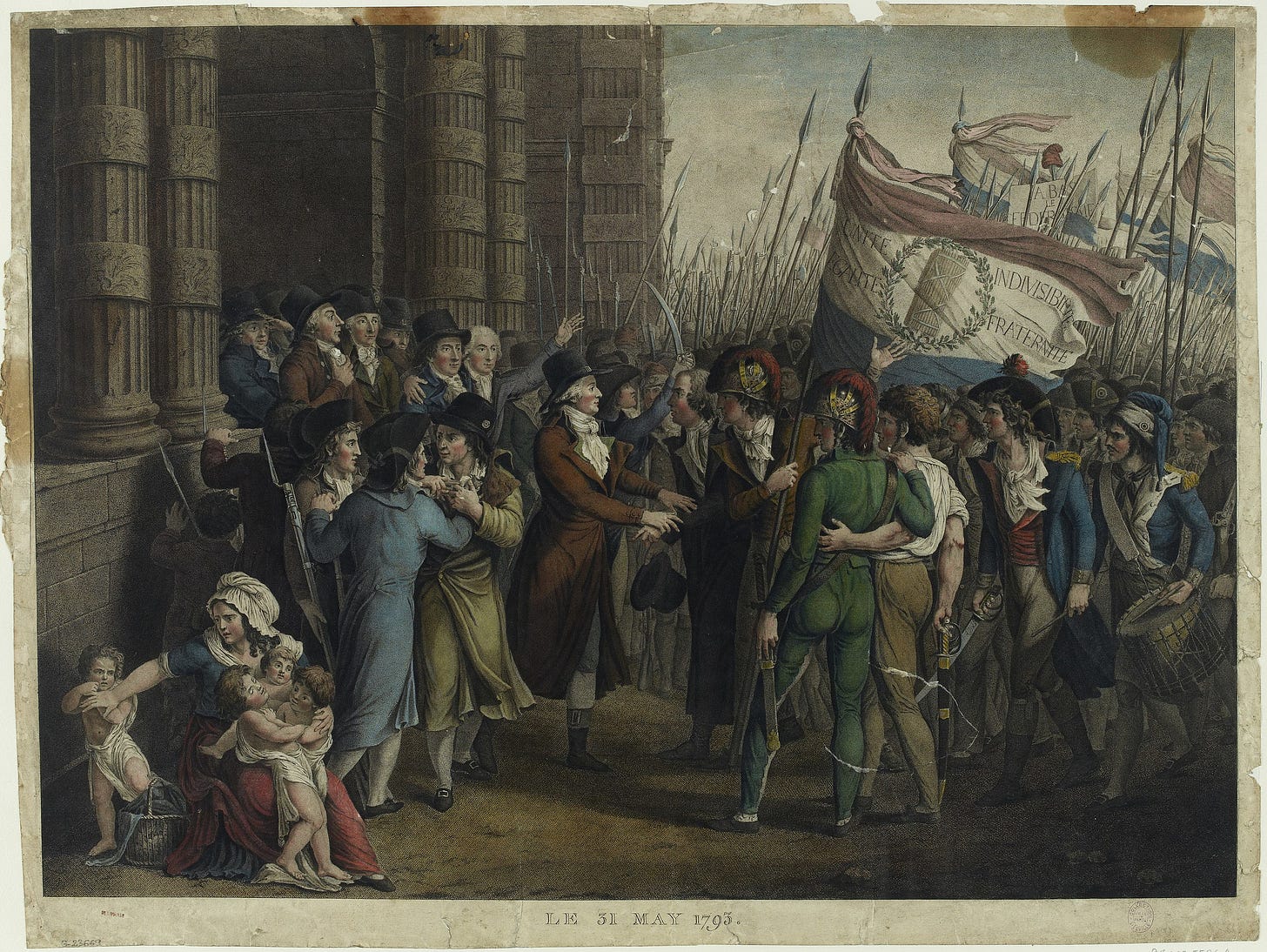
4. The Parisians are revolting
Because of the staccato way in which Mantel tells her story, it is almost impossible to grasp the chronology of the May–June 1793 insurrection that swept away the Girondins and put the Mountain and Robespierre in charge.
On 26 May, Robespierre at the Jacobin Club calls for a popular insurrection against “corrupt deputies.” Note that this is a dramatic shift for Max. He kept a low profile through the violence of 1792, and previously defended law and order against the politics of the street. And Mantel emphasises how Robespierre makes it personal:
‘I invite the people to demonstrate in the Convention itself and drive out the corrupt deputies … I declare that, having received from the people the mission of defending their rights, I regard as my oppressor whoever interrupts me or refuses to let me speak, and I declare I will lead a revolt against the president and all the members who try to silence me. I declare that I will punish traitors myself, and I promise to look upon every conspirator as my personal enemy…’
On 28 May, Robespierre speaks at the Convention and to the Paris Commune, calling again for armed insurrection.
On 30 May, Saint-Just and Georges Couthon join the Committee of Public Safety – both political allies of Robespierre and key orchestrators of the coming Reign of Terror.
The Parisian sections meet to form a new insurrectionary commune led by Enragés, including Jean-François Varlet and Claude-Emmanuel Dobsen.
On 31 May, the insurrection takes over the Hôtel de Ville, and an armed crowd moves to the National Convention, demanding the removal of Girondin deputies and pay for the sans-culottes National Guardsmen. The Convention agrees to some of their demands, but the crowds disperse, and the Girondins remain in their posts.
On 1 June, Marat addresses the Paris Commune and a crowd of 40,000 returns to the National Convention to demand the arrest of 22 Girondin deputies. Girodin newspapers are suppressed, and the insurrectionary commune calls for the arrest of ministers Jean-Marie Roland and Étienne Clavière.
On 2 June, François Hanriot, the commander of the Parisian National Guard, leads a final march on the National Convention. The assembly is besieged. After several attempts to find a compromise and assert its liberty, the Convention votes to suspend the Girondins and put them under house arrest.
The Fall of the Girondins (World History Encyclopedia)
Robespierre’s personal notes on the insurrection from June 1793

5. Arthur Dillon
‘It is a scandal, he must be stopped, he is disgracing his own name.’
You can read Arthur Dillon’s letter to his friend, Camille Desmoulins, here.
Camille responded with a public letter in defence of Dillon. You can read it here in French. It was the worst possible moment to defend an aristocrat, with the Terror about to begin lopping off the heads of anyone with aristocratic sympathies.
‘The People will need a new Friend. It won’t be any of you … You with that filthy swine Dillon.’
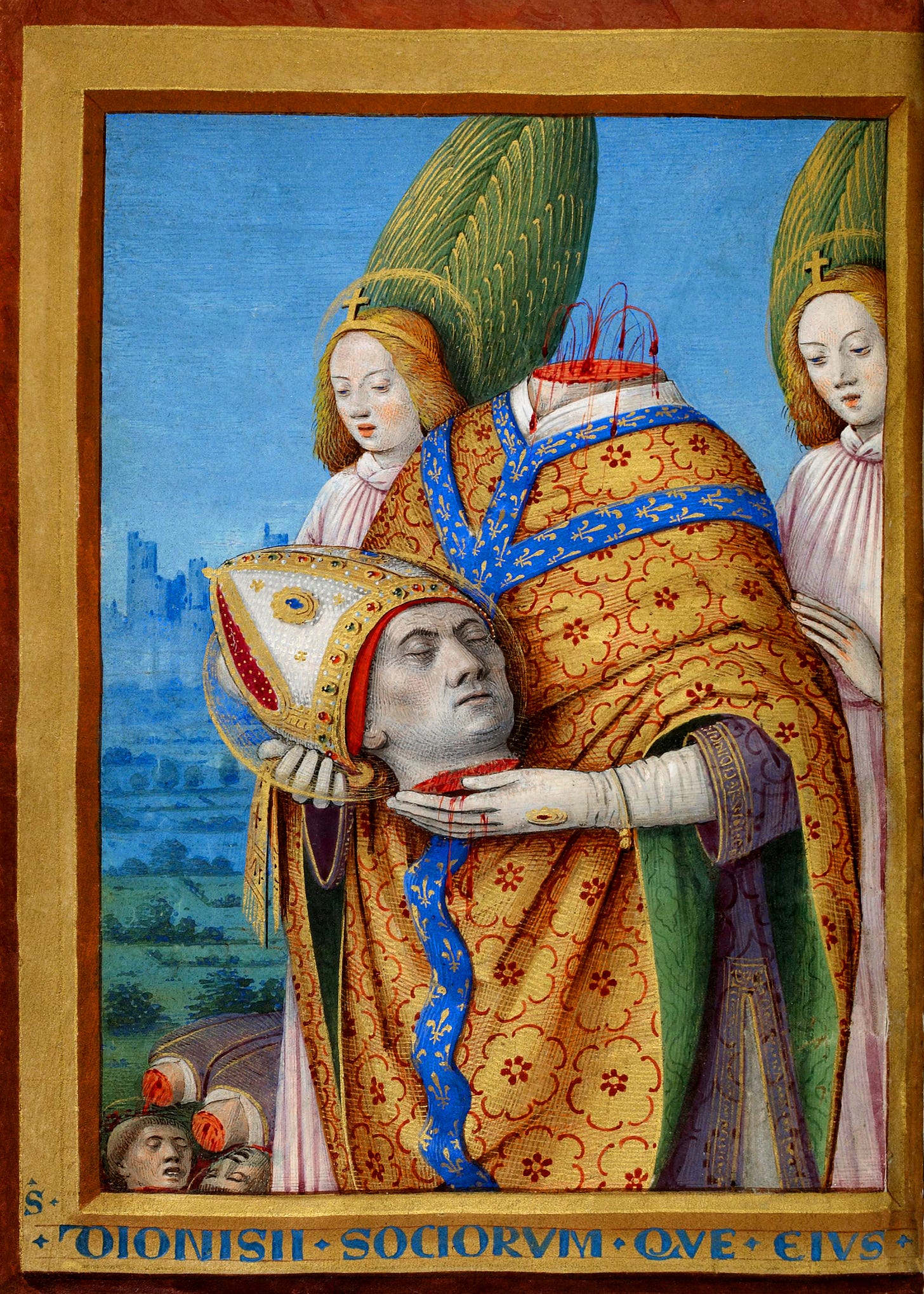
6. Saint Denis
For he had begun to see visions: visions of that saint, France’s patron, who had walked for several leagues with his severed head in his hand. He first saw Denis in the Place de Grève, picking his way over the cobbles. He was neatly truncated, there was no gore; but the head swinging almost casually from his left wrist was Camille’s own. He saw him again going stealthily into the Duplay house, for a private meeting with Robespierre; he saw him waiting outside the entrance to the Jacobin Club – a newly arrived patriot, modest and provincial, wanting an introduction to the great world.
This passage is an early example of the haunting pieces that are integral to the Cromwell books. Camille fears some miserable provincial revolutionary, like Saint-Just, who may wander onto the stage late in the story and call him “a liability.” They’ll later call Saint-Just the “Angel of Death”, and there’s something unstoppable and inevitable about this deathly vision of a headless saint in a private meeting with your old friend Max R.
‘Saints don’t take holidays,’ Camille said. ‘And I prefer to think that although we are instruments of destiny, no one else will do, because we are like saints, agents of a divine purpose, and filled with the grace of God.’
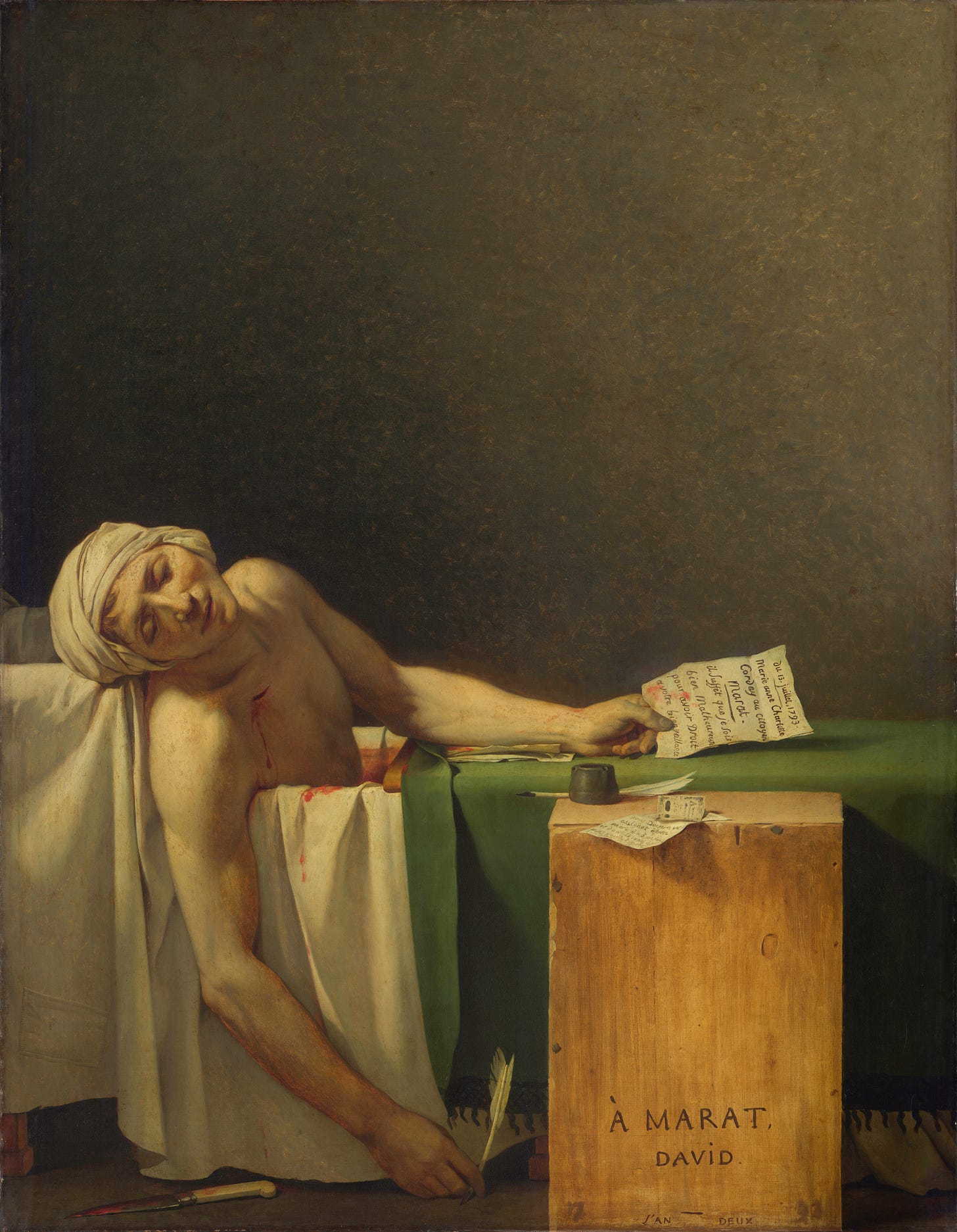
7. The man of blood
‘Yes, aethetic, aren’t I?’ Marat said. ‘A work of art. I ought to be in an exhibition.’
Marat is the subject of the most famous piece of art to come out of this period: The Death of Marat by Jacques-Louis David. Marat’s being ironic, but David chooses not to show his friend’s skin condition: the revolutionary has been made more aesthetic for martyrdom.
The painting was remarkable for portraying a politician and an ordinary citizen in the manner of a Christian martyr or monarch. The letter in the painting, and a copy of Marat’s newspaper, both blood-stained, still exist.
Some of the deputies expelled from the Convention in June had fled to the northwestern city of Caen. There, they had distributed pamphlets calling for the death of Marat. “Let Marat’s head fall and the Republic is saved”, they wrote. “Purge France of this man of blood,” who “sees the Public Safety only in a river of blood. Well then his own must flow, for his head must fall to save two hundred thousand others.”
The phrase “man of blood” is a biblical reference (2 Samuel 16:7-8) that was notably used during the English Civil War to describe Charles Stuart and justify regicide.
Charlotte Corday was living in Caen at this time and decided to act on the calls to assassinate Marat. She went to Paris, bought a kitchen knife at the Palais-Royal and bluffed her way into his house. Prior to killing Marat, she had prepared her “Address to the French, friends of Law and Peace”, explaining her actions:
Marat, whose name alone presents the image of all crime, in falling under the avenging steel, shakes the Mountain and makes Danton grow pale. Robespierre, those other brigands seated upon the bloody throne, are enveloped in the lightning which the avenging gods of humanity only suspend, without doubt, to render their fall more glittering and to affright all those who would be tempted to establish their fortunes on the ruins of an abused people!
Four days after she murdered Marat, Corday was guillotined in the Place de Grève. She had hoped her act would save a hundred thousand lives. Instead, Marat’s death marks the beginning of the bloodiest period of the revolution. With his typical misogyny, Danton sums up where we are:
‘Anyway,’ he said, ‘this finishes the Gironde. Murderers and cowards. They send a woman.’
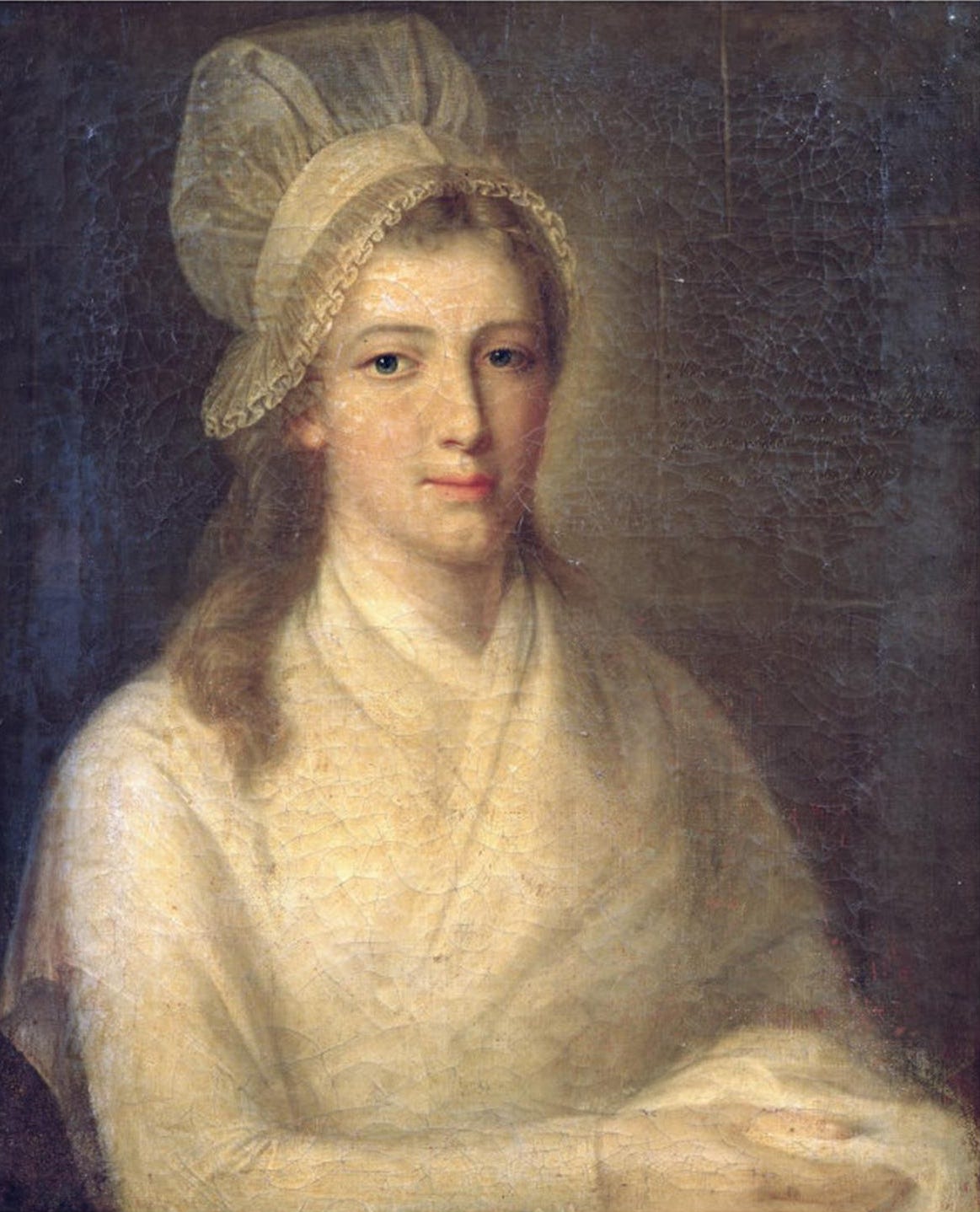
Four years in stale and airless rooms; four years of contention and fright. Georges-Jacques thinks the Revolution is something to make money out of, but now the Revolution is exacting its own price.
Thank you
Thank you for joining me on this slow read.
In the comments, let us know what caught your eye and ask the group any questions you may have. And if you’ve tumbled down a rabbit hole or taken your reading off on a tangent, please share where you have been and what you have found.
Next week, we will read Part Five, Chapter IX. East Indians
Until then, I wish everyone happy and adventurous reading.
Simon


I haven't actually read today's chapters yet, but I got the email right as I was thinking about people's reactions to the Wolf Hall Trilogy v APoGS, so I thought I'd ask: Hilary Mantel loves her morally grey tragic heroes, and yet people seem to interact with Cromwell in a much less morally judgemental way than I've noticed people doing with Danton or Camille or Robespierre on this slow read, even though there's a lot of parallel as all four slowly become "worse" throughout the book/s. I have speculations as to why, but I don't really know, and I'm very curious as to why other people think!
It's all such a mess! Who's sure if who is doing what with whom? I thing Mantel manages to give us the sense of chais brilliantly, but I'm feeling a bit lost with the events. (I think that may be deliberate on Mantel's part.)
I really enjoy the confident writing that allows Mantel to put in a very funny confessional scene in the midst of the drama. And Manon's farewell to her husband is just heartbreaking.
Tangent: a journalist I used to know has published something about a new metro mayor possibly doing things off his own bat without (possibly) getting the right permissions and (allegedly) inappropriately involving his party. I couldn't help thinking that that is exactly what's going on here.
Quick! Send for some decent administrators and governance experts!!